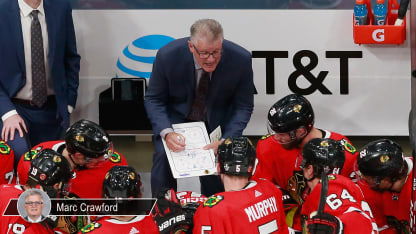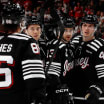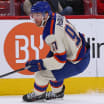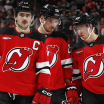The Coaches Room is a regular feature throughout the 2022-23 regular season by former NHL coaches and assistants who will turn their critical gaze to the game and explain it through the lens of a teacher. Marc Crawford, Mark Recchi and Phil Housley will take turns providing insight.
Preparation, coaching key to success on power play, penalty kill
Crawford details what it takes for special teams to be successful

By
Marc Crawford / Special to NHL.com
In this edition, Crawford, coach of the Quebec Nordiques from 1994-95, Colorado Avalanche from 1995-98, Vancouver Canucks from 1998-2006, Los Angeles Kings from 2006-08, Dallas Stars from 2009-11, associate coach of the Ottawa Senators from 2016-19 and assistant coach of the Chicago Blackhawks from 2019-22, looks at what makes the League's top power plays and penalty kills tick.
There are currently 25 NHL teams that have converted at least 20 percent of the time on the power play. In the past, if you were over 20 percent, you were good. The Colorado Avalanche (31.8 percent) are scoring on almost one in every three power plays. That's amazing this deep into the season. There are five teams above 28 percent. I think it is because the execution and the dedication of the players on it. They're willing to watch the tape and work at their skills.
In Chicago, Patrick Kane would always come in and he'd have two or three clips to watch and say, "hey did you see this the other night on their power play? We should try that."
With the overall preparation of the power plays, players on the penalty kill just can't afford to make mistakes because teams are just too good. There are nine teams at 80 percent or better on the penalty kill. Back in the day, eighty percent was considered bad.
Power plays are so important right now. If a team is having trouble scoring at even strength, the power play can be their saving grace. You look at the Vancouver Canucks and how many goals they've scored on the power play this year (25). And teams that are good scoring teams put games out of reach by having such great power lays. That to me would be the Boston Bruins, who have 27 power play goals and are second in the NHL at 29.4 percent. It's almost poison when they get the power play.
What I think is really crucial for teams that have a great power play is the so-called quarterback. The exception may be the Edmonton Oilers because they have such great people down low on their power play, but often times the key is the player carrying the puck into offensive zone. So many teams use him to drop on power plays, but if you have a great puck-carrying defenseman who carries up the ice and is a possibility to take it all the way, that tends to give the team killing the penalty trouble on entries, and the entry is probably the area where you can best defend against great power plays. That's the double whammy of Cale Makar of the Avalanche, Charlie McAvoy of the Bruins, Tyson Barrie with the Oilers, Rasmus Dahlin with the Buffalo Sabres, Miro Heiskanen with the Dallas Stars and Quinn Hughes with the Canucks. Those are the top power plays, and each team has someone who's just dynamite carrying the puck.
Once you get an entry, it comes to the setup. Most teams use the same 1-3-1 setup with a couple of variations. For a defenseman on the power play, they need the ability to walk the line, ability to have deception on the point and quickly give that extra half second to a half-board specialist. There are so many of them with great shots in the League, so many who shoot for sticks, who have the ability to beat you just with their shot because it's so quick and has so much on it. That's a real bonus.
I love the teams that have the great net-front guys on the power play. The one I watched the other night is Edmonton's Zach Hyman, who drives everybody who plays against him crazy. He's a disruptive guy on the power play. You have to remain laser focused on the PK to be successful, and it takes so much experience to do that.
The good penalty killers recognize what net-front guys are trying to do and won't let them do it. it's so important for the net-front defensemen to be in the shooting lane. It's so important if you're going to give anything, they're giving it to one side of the goalies. The goalie knows, predominantly, you're going to get a short-side shot. Good penalty-killing defensemen don't let anyone score on the wide side. That's such a great position because they have to sacrifice their bodies.
There are so many great shot-blocking defensemen in the league who, when they are good, just handle that so well. It's the willingness to be in that lane and to pay the price. Watching in Montreal, Joel Edmundson on that left half wall, he's always in the lane. It's so hard to get the puck past him. For me, it's the willingness and courage that it takes to step in front of those shots all the time, knowing it's coming. The second thing is awareness. Awareness of how the play is developing, awareness of what's happening so you're tying up a stick but also staying in a lane. Good penalty killers never allow anything on the wide side. Marc-Edouard Vlasic is a classic penalty killer with the San Jose Sharks. For the Bruins Boston, take anybody, starting with Brandon Carlo, and you keep going on down the list. The final thing is you have to be disciplined to not get out of your plan. Brady Tkachuk with the Ottawa Senators is such a good net guy and he's also good at making guys lose their focus. Hyman in Edmonton is excellent. They're not only great net guys, they know when to come out at the right time, when to give a jab to someone, get them to lose their concentration for a half second. The discipline on the defender and shot blocker is such an asset.
The two teams that really have outstanding special teams this season are the Bruins and Stars. They have all the elements. On the power play, it's the great point men, awesome people on half boards, bumper in the middle and great net presence. And then the penalty kill you have to have players who are really, really aware. The sacrificing of their body, being willing to block shots, and the discipline to stay compact, to not let anything through the box. If you can have those defenders who have terrific sticks, it's like they're in the lane all the time, they're not letting the power plays do what they want.
From my coaching time, it's so important to have really good coaches. This is where assistant coaches really shine. In Boston you have a few guys who played for me. Assistant coach Chris Kelly was a great penalty killer. He understood it to the nth degree and understands the nuance of all those things I'm talking about. You look on the other side, Joe Sacco is running their power play. The head coaches, their responsibility is they ensure people are executing what the plan is. So much is about the creativity of the players, but you hear so many times, "stay with the program." That's the head coach's job is to make sure they're always staying in tune. But the assistant coaches do so much of the preparation and the video coaches are responsible for getting the clips. The assistants are probably watching every goal the team has scored this year, last year, times that they played a team before. It's such a complex preparation and in this day and age.
You have to give a lot of credit to the athletes, too. For the previous three seasons in Chicago, Kane and Alex DeBrincat worked at the power play every day. They were so in sync with their movement, and that's what's happening on power plays. Players are in sync. You have individual skills that are so necessary, but everybody seems to be doing it the right way, everyone's coaching, very similarly. The power play looks are the same on every team, but execution is through the roof. You'd think it'd be the other way around, everybody's doing this, we should be able to defend. But the execution is so good, and people recognize they have to have options. They come with plans to have other options if their favorite play is taken away, and so often it will be.

















